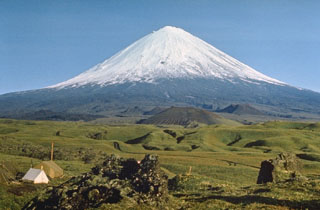Report on Klyuchevskoy (Russia) — 4 July-10 July 2007
Smithsonian Institution / US Geological Survey
Weekly Volcanic Activity Report, 4 July-10 July 2007
Managing Editor: Sally Sennert.
Please cite this report as:
Global Volcanism Program, 2007. Report on Klyuchevskoy (Russia) (Sennert, S, ed.). Weekly Volcanic Activity Report, 4 July-10 July 2007. Smithsonian Institution and US Geological Survey.
Klyuchevskoy
Russia
56.056°N, 160.642°E; summit elev. 4754 m
All times are local (unless otherwise noted)
KVERT reported that seismic activity at Kliuchevskoi had decreased, but remained above background levels during 29 June-6 July. Based on seismic interpretation, ash plumes possibly rose to altitudes of 6-7 km (19,700-23,000 ft) a.s.l. On 4 July, the Level of Concern Color Code was lowered from Red to Orange. During 2-5 July, ash plumes rose to estimated altitudes of 5-6 km (16,400-20,000 ft) a.s.l. based on atmospheric profiles. Plumes were visible on satellite imagery drifting NNW, W, and SE.
Geological Summary. Klyuchevskoy is the highest and most active volcano on the Kamchatka Peninsula. Since its origin about 6,000 years ago, this symmetrical, basaltic stratovolcano has produced frequent moderate-volume explosive and effusive eruptions without major periods of inactivity. It rises above a saddle NE of Kamen volcano and lies SE of the broad Ushkovsky massif. More than 100 flank eruptions have occurred during approximately the past 3,000 years, with most lateral craters and cones occurring along radial fissures between the unconfined NE-to-SE flanks of the conical volcano between 500 and 3,600 m elevation. Eruptions recorded since the late 17th century have resulted in frequent changes to the morphology of the 700-m-wide summit crater. These eruptions over the past 400 years have originated primarily from the summit crater, but have also included numerous major explosive and effusive eruptions from flank craters.

